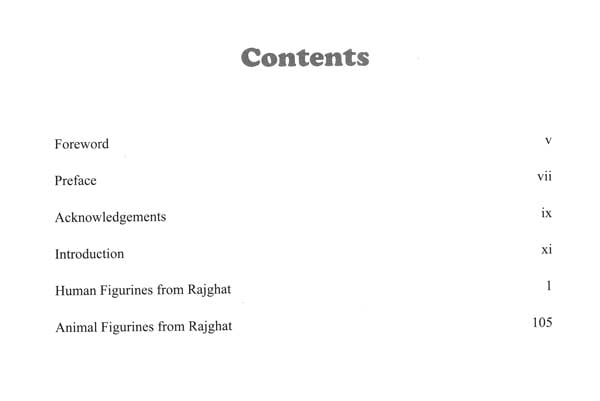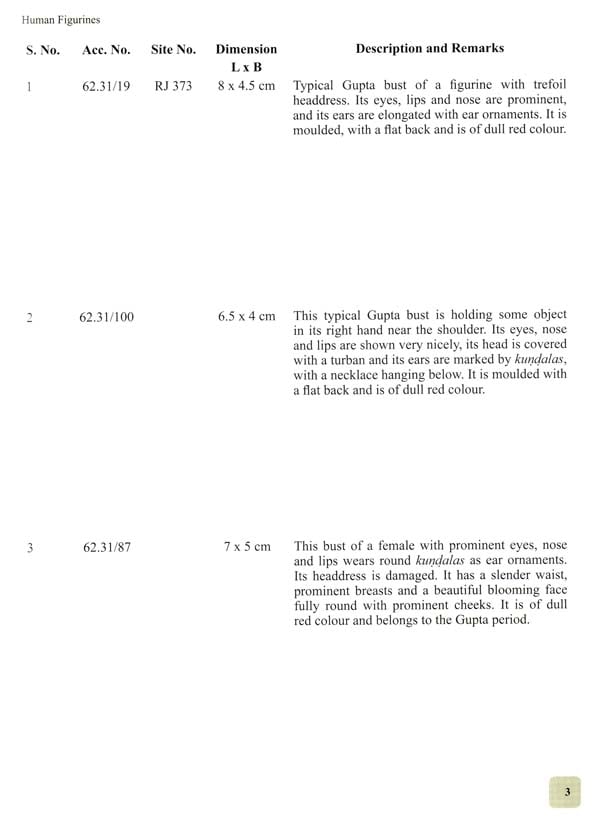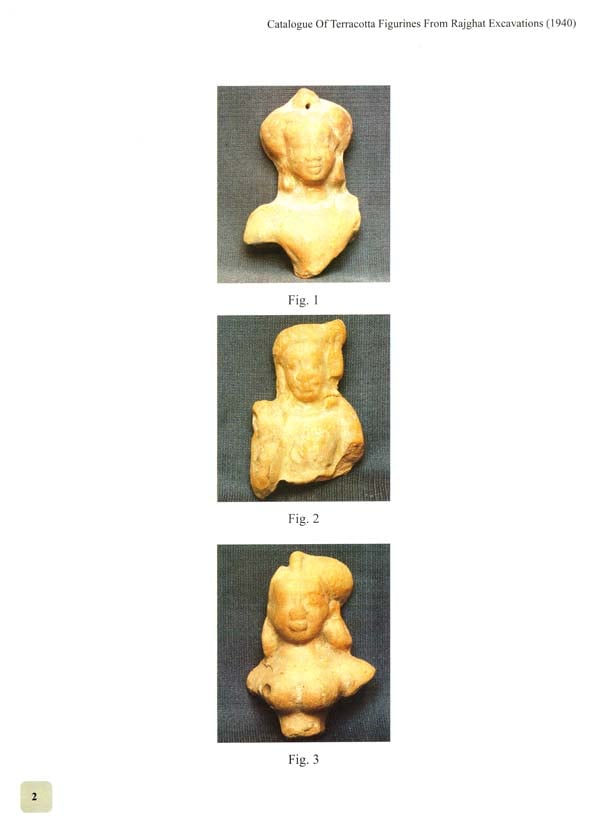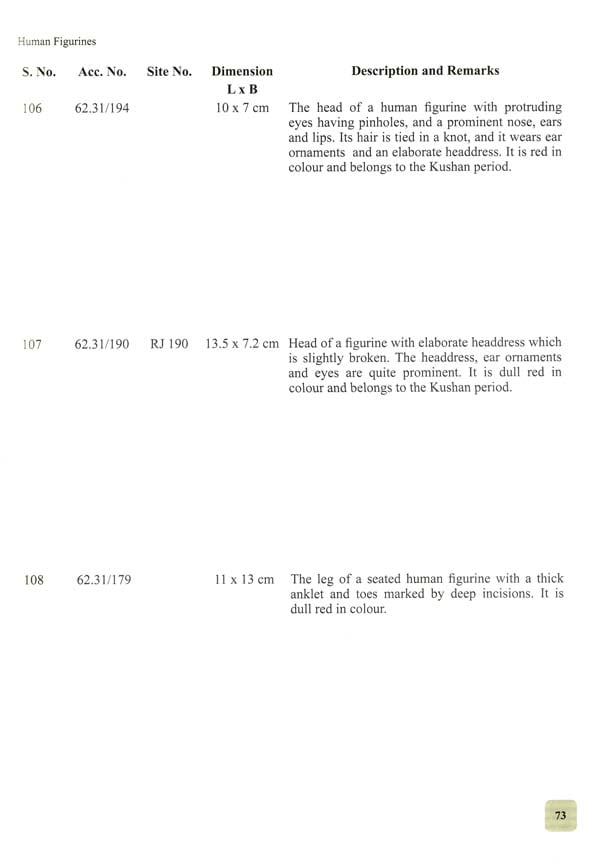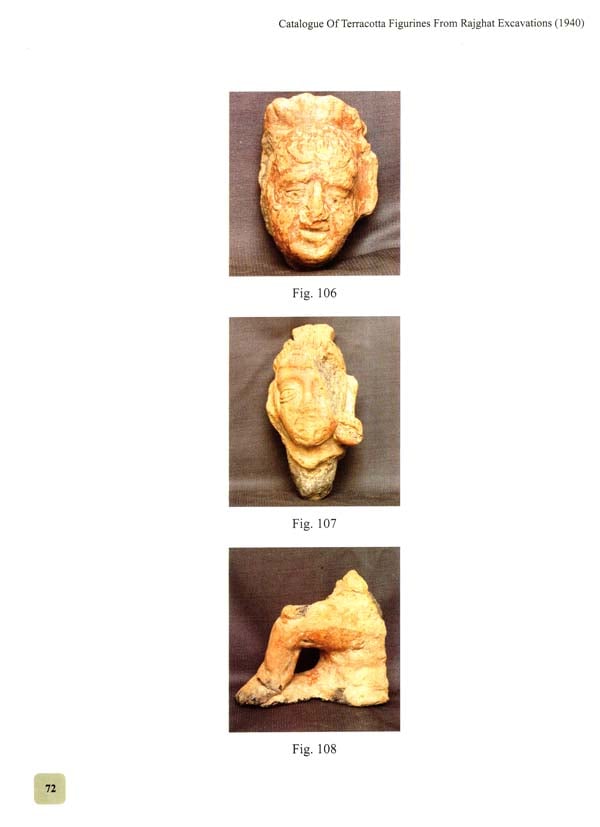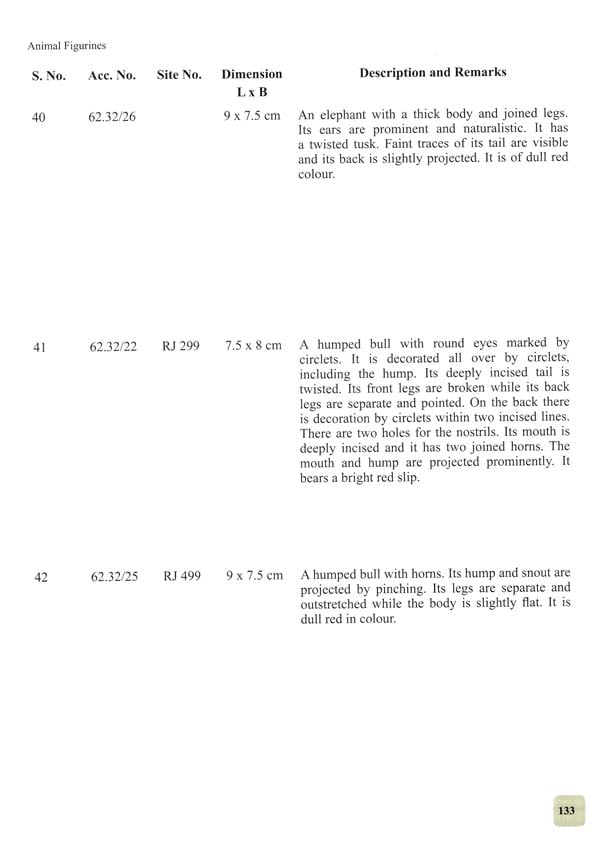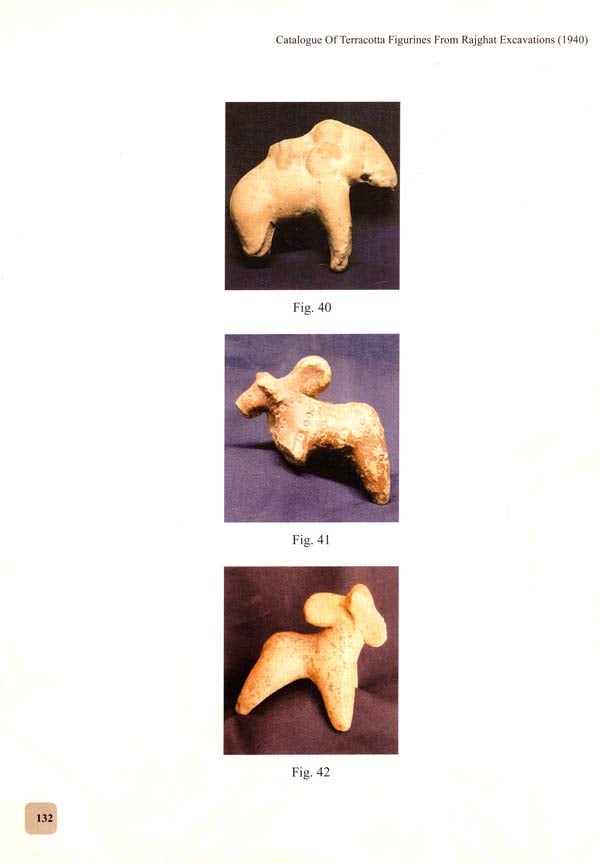
Catalogue Of Terracotta Figurines From Rajghat Excavations (1940)
Book Specification
| Item Code: | NAW950 |
| Author: | B. R. Mani & Arundhari Banerji |
| Publisher: | ARCHAEOLOGICAL SURVEY OF INDIA |
| Language: | English |
| Edition: | 2012 |
| Pages: | 201 (Throughout Color Illustrations) |
| Cover: | HARDCOVER |
| Other Details | 11.50 X 8.50 inch |
| Weight | 1.05 kg |
Book Description
The archaeological mounds at Rajghat represent the ancient city of Kasi or Varanasi on the right bank of the Ganga, located due north of the present day city. Krishna Deva was the first to authentically identify the site when he conducted excavations in 1940 on behalf of the Archaeological Survey of India and found the famous Gupta sealing with the legend `Baranasyadhishthanadhikaranasya' (the seal of the city administration of Varanasi).
Krishna Deva discovered, besides other antiquities, a large number of human and animal terracotta figurines datable from the Sunga-Kushan to the early medieval age. These important pieces remained confined in the Central Antiquity Collection Section of the Archaeological Survey of India in New Delhi and most of the terracottas were not published. Krishna Deva had made a reference to some of these pieces in his paper titled 'Excavations at Rajghat near Banaras' which was published in the Annual Bibliography of Indian History and Indology (Vol. III for 1940) from Bombay in 1944. I am happy to note that Dr. B.R. Mani located the objects and started working on the material and the catalouge is being published by him in collaboration with Dr. Arundhati Banerji.
I am sure the catalogue will find appreciation from the scholarly community and general readers. I congratulate the authors for the worthwhile venture.
Rajghat is an important archaeological site excavated by the Archaeological Survey of India under Krishna Deva in 1940 and later by A.K. Narain and his colleagues of the Department of Ancient Indian History, Culture and Archaeology, Banaras Hindu University in 1957-58, 1960-61 and from 1962-63 to 1960-69. The terracotta figurines are the most interesting class of objects next to seals and sealings found in 1940 excavations which revealed a variety of human and animal figurines. Though, found in all levels, the greater variety could be observed in the Gupta strata which represents the finest examples from this site. Mauryan level did not however, reveal any figurine and the number of figurines from the Sunga level is also very small. The Kushan level of Rajghat yielded along side the finished sophisticated types, degenerate archaic human forms with limbs shown in outlines only. The terracotta figurines from Rajghat are many for which no documentation has ever been done before. Therefore, the authors decided to bring out a Catalogue of this interesting collection from Rajghat, presently housed in the Central Antiquity Collection Section of the ASI at Purana Qila, New Delhi which is of immense value for the study of terracotta art of the Gangetic valley. A number of interesting and significant terracottas were given to the Bharat Kala Bhawan, BHU, Varanasi for display which are not included in this catalogue and may be published in future.
The archaeological mounds at Rajghat (Long. 83° 1' 30" E and Lat. 25° 4' 30" N) represent the ancient settlement of Varanasi on the northern outskirts of the city near the confluence of Ganga and Varana. The credit of the discovery of this ancient settlement goes to Krishna Deva who took up trial excavation of the site on behalf of the Archaeological Survey of India in October-November 1940 after a railway contractor reported ancient remains while digging for spoil earth in connection with extension and remodelling of the Kasi Railway Station.
The discovery of a sealing during the excavation inscribed in Gupta Brahmi characters as Baranasyadhishthanadhikaranasya' i.e. 'the seal of the city administration of B(V)aranasi' marked the site of ancient Varanasi.
Excavations at three mounds at Rajghat were later carried out by A.K. Narain and his colleagues of the Department of Ancient Indian History, Culture and Archaeology, Banaras Hindu University in 1957-58, 1960-61 and from 1962-63 to 1968-69 without any break and substantial archaeological remains were noticed.
Ganga takes a northerly course in Varanasi and therefore it is called Uttaravahini there. On the one hand such a situation added by the confluences of Varana and Asi rivers on the north and south respectively has made the city a sacred area where religious developments increased in the historical times. On the other hand the northerly course of the river has helped in reducing the volume of motion of flow which has also given a semi-circular shape to the left bank of the river making it suitable for anchoring the large sailing boats which were used for the riverine trade down the river upto the Bay of Bengal. Such a location of the city made it a great trading centre which emerged in the middle of the first millennium BC as an urban metropolis with localization and specialization of industries and crafts. The proliferation of the city is elaborately mentioned in the Tripitaka and Jataka tales. There are mentions of ship-building industry, crafts of sandal wood, ivory, cloth praised far and wide for their value and beauty, boats sailing to Suvarnabhumi, location of ivory-workers street (Dantakaravithi) within the city and specialized craft-villages in the vicinity such as village of carpenters (vaddhakigama).
The later excavations at Rajghat by the Banaras Hindu University suggest a cultural sequence beginning from Period IA which has been dated to around 800 BC. The deposit of Period IA represents pre-Northern Black Polished Ware assemblage having plain and painted Black Slipped Ware and Black-and-Red Ware which have also been found at Sarai Mohana, the site across the river Varana near Rajghat. Such cultural assemblage may be pushed back to the later half of the second millennium BC and thus the antiquity of Rajghat also can be pushed back to at least four to five hundred years earlier. Recent excavations around the city at Akatha and Ramnagar also support this early chronology.
The city settlement at Rajghat which already had attained socio-economic prosperity during the pre-Mauryan times had also become great centre of art, culture and religion. Sarnath, the ancient Isipatana or Migadava was selected by Lord Buddha to Turn the Wheel of Law in Motion. Subsequent Sanskrit literature also mentions Varanasi as the city of Kasi mahajanapada located along the Uttaravahini Ganga in between Varana in the north and Asi in the south. Such references are contained in the Matsya, Kurma, Linga, Padma, Agni, Skanda, Bhavishya and other Puranas and Kasi-Khanda. The sacred areas and sacred spots were identified and hundreds of temples and sacred structures were constructed in the Gupta and post-Gupta periods. Chinese travellers Faxian and Xuanzang also indicate such developments.
The elevated landscapes with three higher areas were conceived to be three sectors of the city, namely Onkara-Khanda in the north, Visvesvara-Khanda in the middle and Kedara-Khanda in the south. The ancient city settlement of Rajghat falls under the Onkara-Khanda with its highest plateau among the three, sloping gradually to the low inland ox-bow lakes of Mandakini (modern Maidagin) and Matsyodari (modern Machhodari). One can imagine the extent of the ancient city settlement of Varanasi after observing the elevated area which is mostly occupied by medieval and modern buildings. Varanasi also became famous by other names, such as Ananda-Kanana, Avimukta, Mahasmasana etc. The earliest settlement located at Rajghat was definitely extended upto Lat Bhairava and Bakaria Kund areas from where significant early historic remains, sculptures and architectural fragments have been found. Kasi-Khanda and Linga-Purana also mention about a pillar at Kotisvara and called Mahasmasana-stambha which has been identified with Lat-Bhairava which was probably an Asokan pillar, described to be of 32 to 34 feet in height by the French traveller Tavernier and which suffered damage in 1805.
Although natural soil could not be reached in the excavations conducted at Rajghat in 1940, five strata were identified suggesting five successive cultural periods ranging from Sunga, Kushan-early Gupta, Gupta, late Gupta and Gahadavala age covering a deposit, approximately of 7 m in total.
The Stratum I yielded medieval Brahmanical sculptures and a large number of architectural fragments suggesting remains of a Gahadavala period (1086-1200 AD) temple there. Two copper plate inscriptions of Govindachandradeva were also found. Village Bhadapa is mentioned in one of them which can be identified with the modern Bhadaun, a locality near the site.
The II and III strata were found badly damaged by the Railway diggings.
Stratum IV contained the largest number of structures, at least eight brick-built buildings, laid out in blocks which were separated by lanes and alleys. A rectangular structure about 19 m from east to west and about 16.5 m across with a quadrangle open to sky and a pillared hall in the middle with apartments enclosing it on the sides was expored. It might have been a temple. Other structures belonging to Stratum IV include a curious hall sunk with five masonry wells in its floor, a house containing a lime-plastered rectangular bathing tank, a house with an extensive paved court on which were found a pot with relief designs of flora and fauna, beside hundreds of clay sealings of which particularly important are the sealings of kings Dhanadeva and those bearing the representations of Greek gods and goddesses. On the basis of palaeography of the sealings this stratum has been assigned to the first to third centuries AD.
**Contents and Sample Pages**
